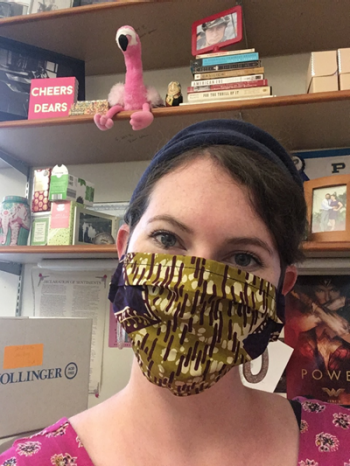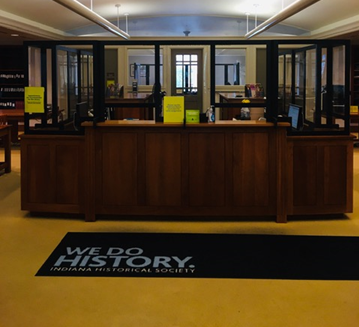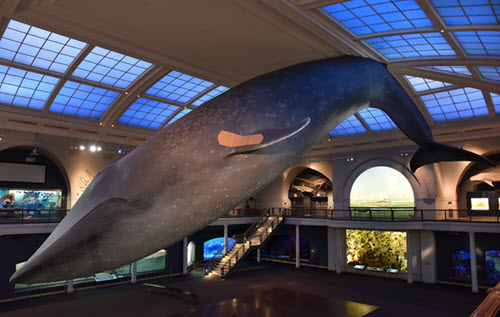Working with Historical Collections during Contemporary Crisis

reopening to the public on July 11, 2020.
As archivist for the Indiana Historical Society, Maire Gurevitz’s role is twofold: unraveling the stories hidden in new and existing collections and helping researchers investigate their own mysteries. COVID-19 presented a new challenge, but one that the Library & Archives team at the Historical Society tackled with the same determination. We talked with Maire about adapting to the limitations of the pandemic and the opportunities it presented for her institution and the field as a whole. The following has been edited for length and clarity.
When COVID-19 struck, how did operations change?
Of course, the immediate change for us was that our governor’s shelter-in-place order closed our building, beginning at 5:00 pm on March 24, 2020. As an archivist, I can’t take collections home with me from our secure stacks. Our team suspected the shutdown was coming, so we prepared some items that we could work on from home and our IT staff set up remote access to our desktops for us. I also went around and snapped a lot of photos of collections items that I thought I might be able to use for online content, such as our institution’s blog or for social media. Luckily, we have a vast digital collection and we’d just finished a grant digitizing a bunch of moving images, so we even had some new content to work with.
When our building reopened to the public on July 6, 2020, we had lots of new safety procedures in place. We were all required to wear masks when we were not in our offices, and all staff meetings (and even some appointments with researchers) were conducted via Zoom. We had plexiglass barriers installed for everyone in public facing roles. For our Library & Archives staff, this meant our Reference Desk and the desk in our Reading Room. Although we still welcomed walk-ins for brief reference interviews or browsing our reference collection and exhibit cases in our space, we asked all researchers to make an appointment to view materials. We also instituted a three-day quarantine on materials used, so we often needed to work with researchers to schedule their visits around those quarantine times. We limited our capacity and spread researchers out at assigned tables in our Reading and Reference Rooms. There was nightly cleaning and disinfecting of all tables and our staff disinfected workstations every day between our reference shift changes.
Currently, our state and our city have lifted the mask mandate and the reduced indoor capacity rules, so we have almost entirely returned to “normal,” but there are some procedures that we’ve decided to keep. We are continuing to ask researchers to schedule appointments if possible (it’s been helpful for our staff to know how to prepare for each day), we still clean and disinfect regularly, and hand sanitizing stations are around the building.

What’s been the impact on you and your work?
When our building shut down, we got very creative to keep our levels of reference, content, and programming as high as possible. It was incredible how quickly and creatively the whole institution made that pivot to exclusively online content. For me, it was so much fun to work on all sorts of different projects—some that came into fruition immediately and some that still haven’t, but maybe we will see someday. I personally expanded my usual job tasks during this time out of necessity (I can’t process collections at home) and also because it was fun to try new things and work more closely with other departments in our institution. However, once we were able to return to our offices in May, the other “normal” parts of my job also resumed, so I think for me, there has not been as much “adapting” as for others who have been working from home for over a year.
During this time, our Library & Archives staff launched an online participatory archiving project, Collecting COVID-19, on the first day of our state shutdown. This is a new(er) adventure for us in collecting entirely born-digital material, and so far, we’ve had over 500 public submissions of photos, artwork, journal entries, poetry, videos, and even some songs. Some of the items we collected are now a part of our Digital Image Collections, but we will also have the collection accessible to researchers in our Library & Archives once the collection is fully processed. Beginning a new collecting initiative that is almost completely made up of born-digital material has also been an opportunity for our Library & Archives staff to set up the infrastructure to safely store and make accessible these types of collections. The lessons we continue to learn from this initiative will help us tweak our methods for the next time we do a participatory archives project. Most importantly, the success of the project has helped accelerate the necessary conversations about digital workflows, storage, and access, that were much easier to push to the side pre-pandemic.
What do you think your work looks like moving forward?
These days, we have mostly resumed regular activity. I hope that everyone gets vaccinated so we can continue to heal and thrive as a community, and that we can again welcome visitors from all over to Indianapolis and to the Indiana Historical Society. I know that as an institution, we will be continuing to provide our visitors and patrons with interesting and engaging online content as well as in-person programming. And of course, our Library & Archives will continue to be available for researchers in person, via email, or by telephone, and my colleagues and I will continue to process and make available our collections that help us tell Indiana’s story.
What have you learned that could be helpful to other libraries and museums?
I hope this experience has taught everyone that perhaps some systems that were in place pre-pandemic are not serving us—as staff, administration, and visitors. We have more work to do in increasing access, compensation, representation, etc. We are all questioning ourselves and our field right now, and I don’t think that is a bad thing. I hope it continues. Especially if we eventually end up with libraries and museums that are truly doing the work and living up to their calling to educate, inspire, and create.
Images courtesy: Maire Gurevitz
Related stories
Libraries and Museums as Vaccination Sites
Libraries and museums are innovative community centers, and throughout the COVID-19 pandemic, they have been essential to the community and national response.
Want to learn more?
More resources are available through the REALM project website.
This project was made possible in part by the Institute of Museum and Library Services, project number: ODIS-246644-ODIS-20.

